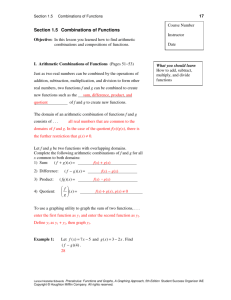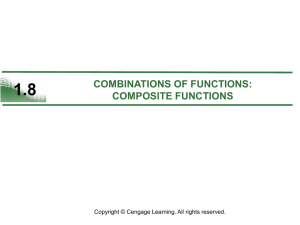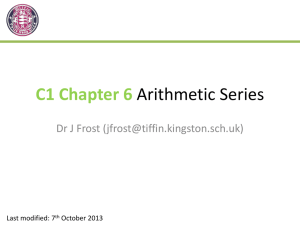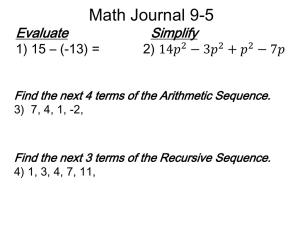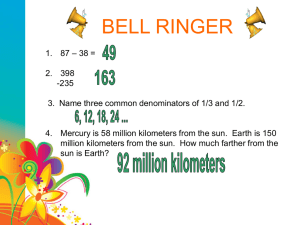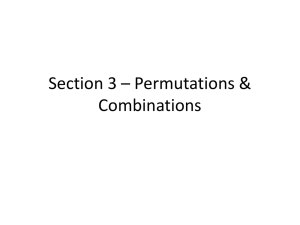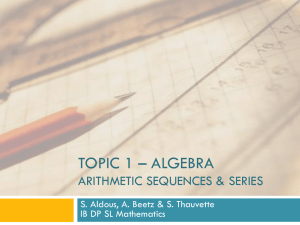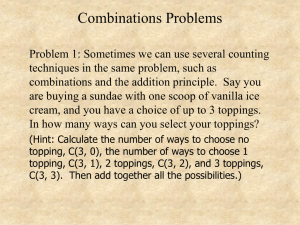Arithmetic Combinations
advertisement
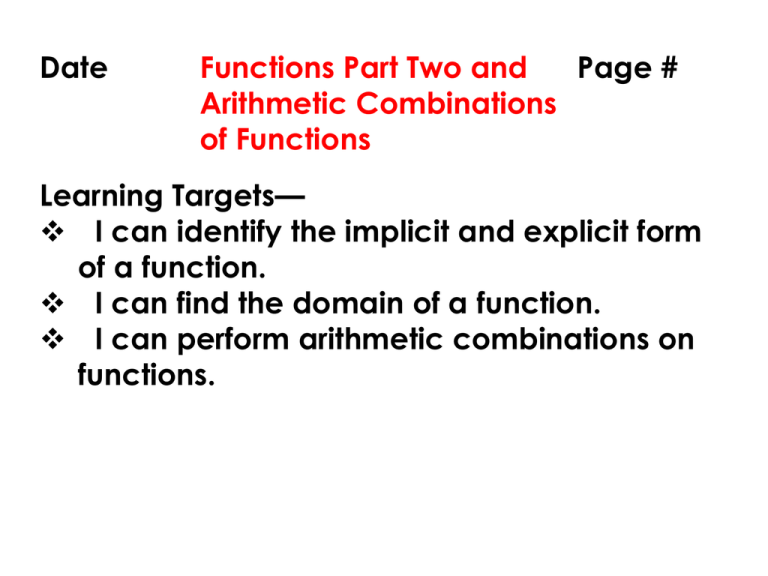
Date Functions Part Two and Page # Arithmetic Combinations of Functions Learning Targets— I can identify the implicit and explicit form of a function. I can find the domain of a function. I can perform arithmetic combinations on functions. Functions Part Two and Arithmetic Combinations of Functions Admit Slip— Page 69, #83 - 85 Implicit and Explicit Form of a Function In general, when a function f is defined by an equation in x and y, we say that the function f is given implicitly. If it is possible to solve the equation for y in terms of x, when we write y = f(x) and say that the function is given explicitly. Implicit Form 3x+y=5 Explicit Form y = f(x) = -3x + 5 x2 – y = 6 y = f(x) = x2 – 6 xy = 4 y = f(x) = 4/x Important Facts About Functions • For each x in a domain of a function f, there is exactly one image f(x) in the range; however, an element in the range can result from more than one x in the domain. • f is the symbol that we use to denote the function. It is symbolic of the equation that we use to get from an x in the domain to f(x) in the range. • If y = f(x), then x is called the independent variable or argument of f, and y is called the dependent variable or the value of f at x. Finding the Domain of a Function Often the domain of a function f is not specified; instead, only the equation defining the function is given. In such cases, we agree that the domain of f is the largest set of real numbers for which the value of f(x) is a real number. The domain of a function f is the same as the domain of a variable x in the expression f(x). Domain The implied domain of a function is the set of all real numbers for which the expression is defined. In general, the domain of a function excludes: • values that would cause division by zero • values that would result in the even root of a negative number. Domain Find the domain of each of the following functions: a) f(x) = x2 + 5x b) f(x ) = c) f(x ) = 3x x 2 - 4 4 - 3 x Domain 1. Find the domain of each function. f(x ) = 3 x g (x ) = h (y ) = 2 3x + 5 2 + 5 x + 4 3y - 12 Domain 2. Find the domain of each function. 4 f(x ) = x s(y ) = 3y y + 5 g (x ) = 1 - 2 x 2 Domain 3. Find the domain of each function. g (a ) = f(t) = g (x ) = a - 10 3 t+ 4 1 3 x - x + 2 Domain 4. Find the domain of each function. 10 f(x ) = 2 x - 2x g (x ) = h (s) = 21 x 2 + 5x + 6 s - 1 s - 4 Domain When we use function in applications, the domain may be restricted by physical or geometric considerations. For example, the domain of the function f defined by f(x) = x2 is the set of all real numbers. However, if f is used to obtain the area of a square when the length x of a side is known, then we must restrict the domain of f to the positive real numbers, since the length of a side can never be 0 or negative. Domain Express the area of a circle as a function of the radius. Find the domain. 5. Express the area A of a rectangle as a function of the length x if the length of the rectangle is twice the width. Find the domain. Domain 6. Express the gross salary G of a person who earns $10 per hour as a function of the number x of hours worked. Find the domain. Arithmetic Combinations Sum f + g (x ) = Difference f - g (x ) = Product f Quotient f(x ) + g (x ) f(x ) - g (x ) g (x ) = f (x ) f f(x ) (x ) = g (x ) g g (x ) g (x ) 0 Arithmetic Combinations y = g (x ) y = f(x ) Find the following: (f + g )(3 ) = (f - g )(1 ) = (f g ) (4 ) = ( f g )(2 ) = Arithmetic Combinations y = g (x ) y = f(x ) 7. Find the following: (f + g )(1 ) = (f - g )(2 ) = (f g ) (0 ) = ( f g )(3 ) = Arithmetic Combinations f(x ) = x 2 + 1 (f + g )(3 ) = (f - g )(0 ) = (f g ) (4 ) = ( f g )(5 ) = g (x ) = x - 4 Arithmetic Combinations f(x ) = x 2 + 1 8. Find the following: (f + g )(1 ) = (f - g )(-2 ) = (f g ) (-6 ) = ( f g )(0 ) = 2 f (5 )= g (x ) = x - 4 Arithmetic Combinations f(x ) = x 2 + 9x + 20 f + g (x ) = g (x ) = x + 4 Arithmetic Combinations f(x) = x 2 + 9x + 20 f - g (x ) = g(x) = x + 4 Arithmetic Combinations f(x) = x 2 f g (x ) = + 9x + 20 g(x) = x + 4 Arithmetic Combinations f(x) = x 2 f (x ) = g + 9x + 20 g(x) = x + 4 Arithmetic Combinations 2 f(x ) = x - 4x - 21 9. Find the following: f + g (x ) f - g (x ) f g (x ) = f (x ) = g = = g (x ) = x + 3 Functions Part Two and Arithmetic Combinations of Functions Assignment— Page 67 1-14 (Are you prepared, Concepts and Vocabulary) Page 68 48-60 even (Find the domain) Page 68 62, 64, 68, 70 (Use the arithmetic combinations) Page 69 92, 96, 102 (Applications) Functions Part Two and Arithmetic Combinations of Functions Exit Slip— Page 70 #104
